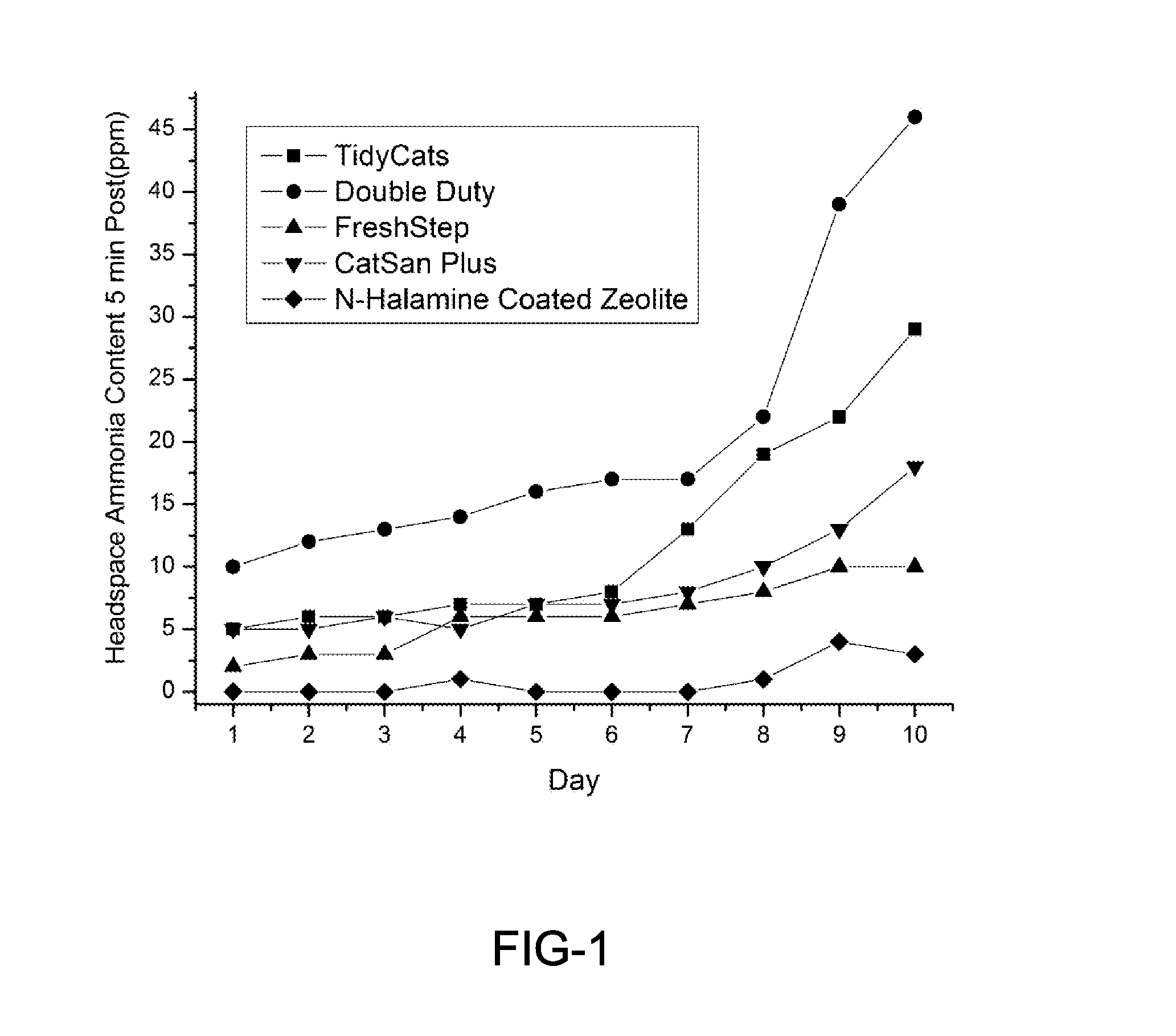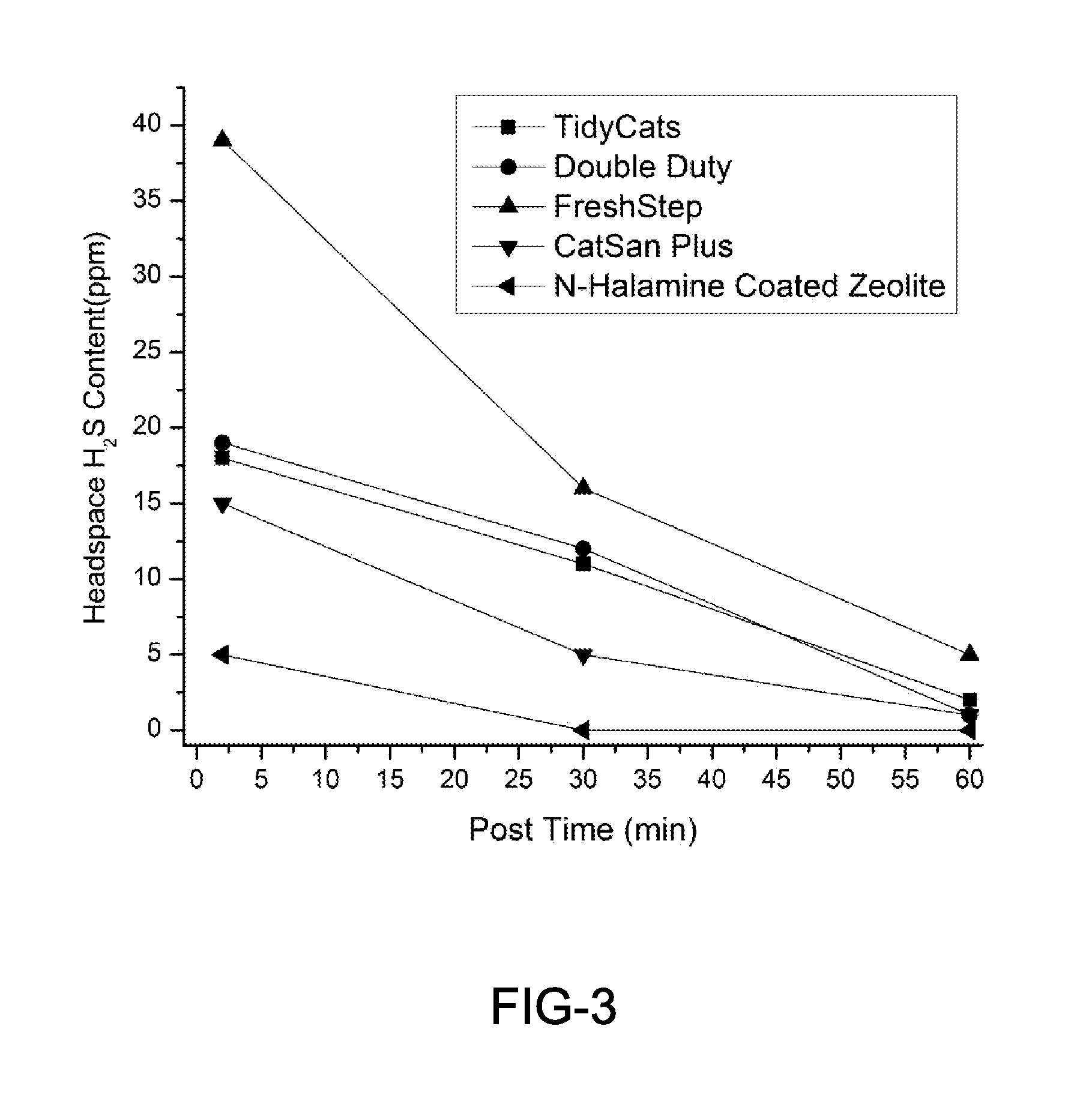Antimicrobial compositions and methods with novel polymeric binding system
a technology of polymeric binding and composition, applied in the field of antimicrobial compositions and deodorizing materials, can solve the problems of morbidity and mortality, increase hospital stays and costs, and health care-associated infections (hais) remain one of the most pressing and expensive healthcare problems in the world, and achieve the effect of reducing the odor of free halogen
- Summary
- Abstract
- Description
- Claims
- Application Information
AI Technical Summary
Benefits of technology
Problems solved by technology
Method used
Image
Examples
example 1
[0088]This example illustrates the comparison of different disinfecting fluid formulae. Three aqueous N-halamine solutions were made, one with no other components in addition to the N-halamine, one with the addition of a binding agent / stabilizing constituent, and one with the addition of a halogen stabilizer. For the control, Sample 1, 10 grams of 2-chloro-1,3,5-triazine-2,4,6-triamine and 0.05 gram of Triton X-100 were added into 1000 ml of deionized water. For Sample 2, 10 grams of 2-chloro-1,3,5-triazine-2,4,6-triamine, 3 grams of guar gum, and 0.05 gram of Triton X-100 were added into 1000 ml of deionized water. For Sample 3, 10 grams of 2-chloro-1,3,5-triazine-2,4,6-triamine, 0.5 gram of 2,2,6,6-tetramethyl-4-piperidyl methacrylate, 3 grams of guar gum, and 0.05 gram of Triton X-100 were added into 1000 ml of deionized water. After 24 hours of agitation under room temperature, a clear solution was achieved for sample 1; a clear and slightly thick solution was achieved for Sampl...
example 2
[0089]This example illustrates the capacity of the aqueous N-halamine fluids to be taken up by a fabric substrate using a typical dip-pad-dry procedure commonly applied in finishing textile fabrics. A finishing bath containing 20 grams of 1-chloro-5,5-dimethylhydantoin, 2 grams of 2,2,6,6-Tetramethyl-4-piperidyl methacrylate, 3 grams of hydroxyethyl cellulose, and 0.2 gram of Triton X-100 in 1000 ml of deionized water was prepared. Then for the “dip-pad-dry” procedure, 200 grams of polypropylene non-woven fabric were dipped in the bath at room temperature for at least 5 min to absorb components from the aqueous finishing bath. The fabrics were put into a laboratory wringer to remove the excess solution, resulting in more than 60% wet pickup of the fluid finish. The fabric was dried at a temperature of 80° C. and used to demonstrate functions acquired by the textile attributable to the finish.
example 3
[0090]Textile samples prepared with a finish as described in Example 2 were tested to measure the active chlorine contents by iodometric titration as an indicator of the successful application of a finish coating to the synthetic fibers of the textile. 0.5˜1 g of coated fabrics were cut into fine fragments, and treated with a solution of one g of KI in 100 mL of deionized water (the solution contained 0.05% (v / v) of TX-100) at room temperature under constant stirring for 1 hour. The amount of Iodine (I2) formed was titrated with standardized sodium thiosulfate aqueous solution. The uncoated fabrics were tested under the same conditions to serve as controls. The available active chlorine content on the fabrics was calculated according to equation (1):
Cl%=35.52×(VS-V0)×CNa2S2O3WS×100(1)
where VS, VO, CNa2S2O3 and WS were the volumes (mL) of sodium thiosulfate solutions consumed in the titration of the coated and uncoated samples, the concentration (mol / L) of the standardized sodium thi...
PUM
| Property | Measurement | Unit |
|---|---|---|
| thick | aaaaa | aaaaa |
| thick | aaaaa | aaaaa |
| thick | aaaaa | aaaaa |
Abstract
Description
Claims
Application Information
 Login to View More
Login to View More - R&D
- Intellectual Property
- Life Sciences
- Materials
- Tech Scout
- Unparalleled Data Quality
- Higher Quality Content
- 60% Fewer Hallucinations
Browse by: Latest US Patents, China's latest patents, Technical Efficacy Thesaurus, Application Domain, Technology Topic, Popular Technical Reports.
© 2025 PatSnap. All rights reserved.Legal|Privacy policy|Modern Slavery Act Transparency Statement|Sitemap|About US| Contact US: help@patsnap.com



